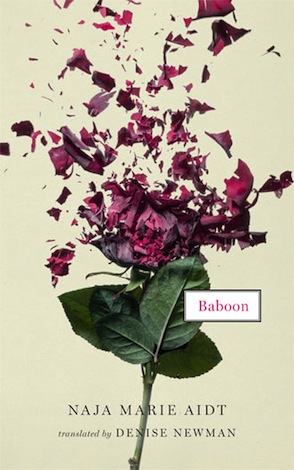Baboon
by Naja Marie Aidt
reviewed by Jennifer Kurdyla
The best short stories make you feel as if you’ve walked by a curious-looking house, observed curious things through the window, and then walk on contemplating the ramifications—large and small—of what you’ve just witnessed. In Naja Marie Aidt’s Baboon, however, the things we observe are more than curious—they’re startling, and rather than walking on, we can’t help but stop dead in our tracks to consider what just transpired, and what it means about human nature.
In “Mosquito Bite,” we see where the collection gets its name as one character’s bug bite turns his backside as pink and swollen as the rear of a primate—and yet, Aidt pulls down no shades. She forces us to stare at the ugliest side of these individuals, and thus ourselves, resulting in a reading experience that is as exhilarating as it is troubling.
The author of nearly twenty books in her original Danish, Aidt is a fiction writer and poet whose work has been recognized internationally; Baboon (originally published in 2006 as Bavian in Danish) won the Danish Critics Prize for Literature in 2007 and the Nordic Council’s Literature Prize in 2008. The 2014 translation of the collection is the first time her work has appeared in English, and it was long-listed for the 2015 Best Translated Book Award for fiction. She is no doubt part of the boom of Nordic literature in the US, and yet Aidt delivers something very different. The quotidian aspects of life that captivate readers in Karl Ove Knausgaard’s novels, for instance, are the impetus for high drama in Baboon: what is “normal” about domestic conflict explodes into worst-case-scenario levels of urgency and transformation.
The story “Sunday” embodies this idea of unearthing the strange in the commonplace. When a group of adults and children take a weekend outing, “the neighborhood was abuzz with Sunday and late summer; people were busy with garden work and afternoon coffee . . . The strong orange afternoon light made everything look clear and almost surreal.” Nothing terribly strange here, but in the course of the story’s four pages we get a full sense of one female character’s unsettled state: remembering the saddest song of her childhood, noting the swarm of mosquitoes around her head, recalling the odd specks in her ex-husband’s eyes. All that came before the weird tension of their simple trip to get pastries; then the reason they’re at the house of another woman comes into new focus, and we see that the idyllic family life is anything but. Aidt’s ability to distill such pent-up emotion into concise language is evidence of her poet’s hand, and yet the plainspoken nature of the prose (a tribute to Newman’s translation) keeps the stories moving.
In “Wounds,” Aidt describes a transfer of energy between people and their environment: “The city—bathed in sunlight and a dry haze—reminded me in a moving and visceral way how everything depends on who is doing the observing and where you are observing from, and I thought: This is so incredibly banal, and yet it’s so important.” The meandering streets of the city come to reflect a meandering narrative of banal tasks, but the banality comes to a head in the final moments of the story, when the protagonist’s physical and emotional “wounds” are exposed in their shameful glory.
In these terrifically unsettling stories, with their first-, second-, and third-person narration, Aidt encourages us to look around. There’s no guarantee, though, that we’ll like what we’ll see. Indeed, something as innocuous as a mosquito bite can turn into a year-long trial of pain and the realization that you’re “not the same person anymore, no pride, no joy, no recognition,” or that “you don’t even know yourself.”
Published on September 3, 2015

